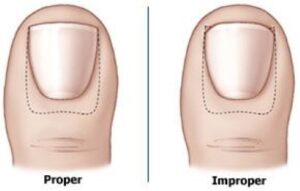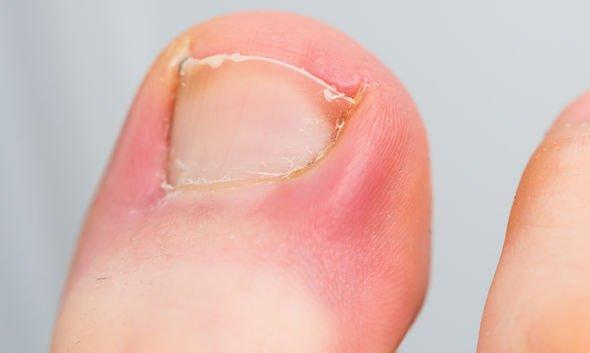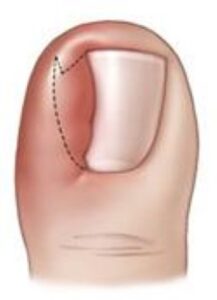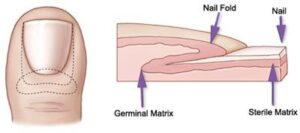Ingrown toenails are a prevalent and often painful condition, particularly common among teenagers. This occurs when the nail’s edges press into or grow into the surrounding skin, leading to discomfort and potential damage to the skin tissue. In some cases, the skin on one or both sides of the nail may also grow over the nail edges.
Several factors can increase the likelihood of developing an ingrown toenail, including:
- Cutting toenails too short, especially at the sides of the big toe.
- Shaping toenails to follow the curve of the toe rather than trimming straight across.
- Wearing shoes that are overly tight or too short, causing excessive pressure on the toes.
Anatomy of the Toenail
A toenail consists of four key components:
- Nail Plate: The hard, visible portion of the nail that grows outward and is regularly trimmed.
- Nail Fold: The tissue surrounding the nail plate, which can become inflamed or infected in cases of an ingrown toenail.
- Nail Bed: Composed of the germinal and sterile matrix, this structure both produces the nail and anchors it securely in place.
- Cuticle: The soft tissue at the base of the nail that forms a protective seal between the nail and the nail fold.
Causes of Ingrown Toenails
Ingrown toenails can develop due to a variety of factors:
- Some individuals are born with nails that are naturally too large for their toes.
- Trauma, such as stubbing the toe or having it stepped on, may contribute to the condition.
- The most common causes are wearing tight or ill-fitting shoes and improper toenail trimming techniques.
Symptoms of Ingrown Toenails
An ingrown toenail initially presents as a hard, swollen, and tender area around the affected nail. As the condition progresses, the corner of the nail may become red, painful, and swollen. If left untreated, infection can develop, often accompanied by drainage of pus from the site.
Treatment Options for Ingrown Toenails
Nonsurgical Treatments
Early intervention is crucial for managing ingrown toenails before infection develops. Recommended steps include:
- Soaking the affected foot in warm water 3–4 times daily.
- Keeping the foot dry when not soaking.
- Wearing shoes with ample room for the toes or opting for sandals until the condition improves.
- Using over-the-counter pain relievers such as ibuprofen or acetaminophen to manage discomfort.
- If symptoms persist or worsen after 2–3 days, contact a healthcare provider.
In some cases, it may be necessary to gently lift the ingrown nail edge and place a small piece of cotton or waxed dental floss underneath to prevent further embedding. This packing should be changed daily.
Surgical Treatments
If the ingrown toenail is severely inflamed, swollen, painful, or shows signs of infection, medical intervention is often required. A physician may prescribe oral antibiotics and recommend partial or complete nail removal.
During surgical treatment, the doctor may remove:
- A section of the nail
- Part of the underlying nail bed
- Surrounding soft tissue
- A portion of the nail’s growth center (if needed to prevent recurrence)
By understanding the anatomy, causes, symptoms, and treatment options, individuals can better manage or prevent ingrown toenails, ensuring healthier feet.
 Possible treatment options for an ingrown toenail.
Possible treatment options for an ingrown toenail.
Surgical Treatment for Ingrown Toenails
Surgical intervention is highly effective in preventing the nail edge from growing inward and cutting into the surrounding skin as the toenail grows.
- Partial Nail Avulsion:
If pain is severe or infections are recurrent, your doctor may perform a partial nail avulsion. During this procedure, an anesthetic is injected into the toe to numb the area. The ingrown portion of the nail is carefully removed using surgical scissors, ensuring the nail bed remains intact. While this treatment alleviates the problem, the exposed nail bed may cause temporary discomfort. - Complete Nail Plate Avulsion:
In some cases, the entire toenail may be removed. However, this approach increases the risk of the nail regrowing in a deformed manner. Nail regrowth typically takes about 3 to 4 months. - Permanent Nail Removal:
For children or individuals with chronic and recurrent infections, permanent removal of the toenail may be recommended. This prevents further complications and ensures long-term relief.
Preventing Ingrown Toenails
Taking preventive measures can significantly reduce the likelihood of developing ingrown toenails, particularly if the condition is not congenital. Best practices include:
- Protect Your Feet: Avoid trauma to the toes by being cautious of injuries.
- Choose Proper Footwear: Wear shoes and socks that provide ample room for your toes to move freely.
- Trim Nails Correctly: Use a clean, sharp nail trimmer to cut toenails straight across without tapering or rounding the edges. Avoid cutting nails too short.
- Maintain Foot Hygiene: Keep your feet clean and dry, except during water-based activities like bathing or swimming.
By following these guidelines and seeking timely treatment for existing issues, you can minimize discomfort and maintain healthy toenails.
 When trimming your toenails, cut straight across — no tapering or rounding at the corners.
When trimming your toenails, cut straight across — no tapering or rounding at the corners.







